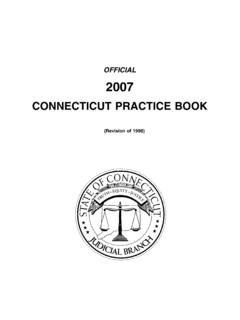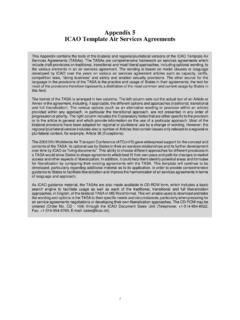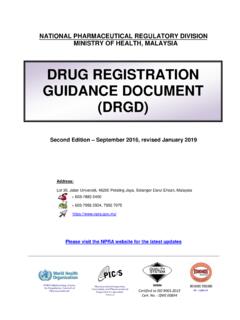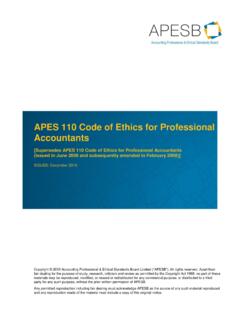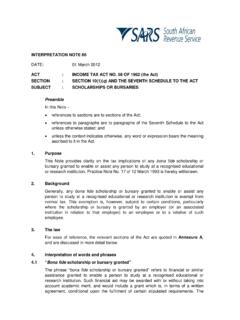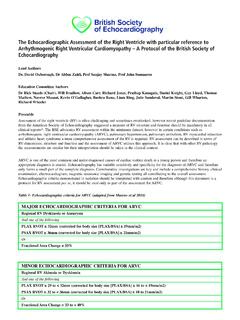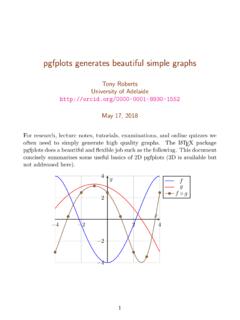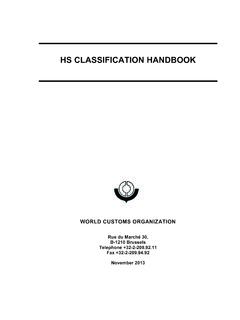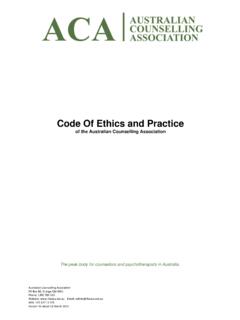Transcription of Guidelines and Space Standards for Barrier Free Built ...
1 Guidelinesand Space Standards for Barrier Free Built Environment for Disabled and Elderly PersonsPreambleThe main objectives of the "Persons with Disabilities (Equal Opportunities, Protection of Rights and Full Participation) Act, 1995enacted by the Government of India on January 1, 1996 are to create Barrier free environment for persons with disabilities and tomake special provisions for the integration of persons with disabilities into the social VII of the Act, Sections 44 to 46 deal with non-discrimination in transport on the roads and in the Built environment. Itenjoins upon the governments and local authorities to ensure within their economic capacity provision for installation of auditorysignals at red lights in the public roads for the benefit of persons with visual handicaps, kerbs and slopes to be made inpavements for the easy access of wheel chair users, devising appropriate symbols of disability an warning signals at regard to non-discrimination in the Built environment, provisions have been made in this Act for ramps in public buildings,adaptation of toilets for wheel chair users, Braille symbols and auditory signals in order to create a Barrier free environment in consonance with the provisions of the Act, the Government of India (Ministry ofUrban Affairs & Employment)
2 Is currently engaged in the process of amending/modifying the existing building bye-laws whichwould be applicable to all buildings and facilities used by the this intention to ensure that everyone, including the physically disabled and elderly persons will have equal access in everyday life in the city, the Min. of UA&E has constituted a committee under the chairmanship of DG(W), CPWD with the followingmembers for the purpose of developing comprehensive Guidelines and Space Standards for Barrier free Built environment fordisabled and elderly General (Works), Architect I, CPWDM ember Planner, Architect, Architect, Engineer, MCDM emberThe access Standards codes have taken into consideration the access needs of diverse disability groups, such as persons withmobility, speech, hearing, and visual impairments by meeting disabled peoples Standards for safety, convenience and " Guidelines and Space Standards for Barrier Free Built Environment for Disabled and Elderly Person" have also consideredthe comments received from School of Planning and Architecture (SPA)
3 CBRI, Handicapped Welfare Federation (NGO) andNational Federation of Blind (NGO).The scopes and responsibilities which have been identified in various organizations will include the followings:Academic InstitutionThere should be a conscious attempt of all educationalists to develop young architects/planners with an awareness ofcreating Barrier free environment for physically detail design exercise should be carried out in all schools of Architecture in their curriculums as an essential subject ofarchitecture Govt. AgenciesThe Govt. departments should follow the recommended Standards of provisions for disabled alongwith the Bodies/CorporationsThe building codes should specify basic architectural provisions that need to be incorporated in new buildings to makethem convenient for integrated effort should also require from all local authorities to update their building authorities/corporations should ensure, before giving permissions of construction, the provisions of steplesssystem for easy access to buildings, lifts for free access to upper floors, adequate doors width for wheel chairs entry andaccessible TopicsIntroduction Type of Disabilities Mobility Devices Controls Construction and Maintenance StandardsClassification of BuildingsMin.
4 Access Provisions Required in Various Types of BuildingsDesign Elements within the Building PremisesSite PlanningTypical Detail of Walkway Approach to Plinth Level Ramp Details Entrance Landing CorridorEntrance/Exit Door Windows Steps and Stairs LiftToilet Typical Toilet Signages Guiding/Warning Floor Material Other Facilities Design Elements Outside the Building Road Crossing Public Toilets Bus Stops Taxi Stand Telephone Booth Residential Buildings Kitchen Livingroom and Bedroom Bathroom Guest House Auditorium Parks Restaurant Railway Stations Model Building bye-laws to provide facilities for physically handicapped persons explanatory notes BibliographyIntroductionBarrier Free Environment is one which enables people with disabilities to move about safety and freely and to use the facilitieswithin the Built environment.
5 The goal of Barrier free design is to provide an environment. The gaol of Barrier free design is toprovide an environment that supports the independent functioning of individuals so that they can get to, and participate withoutassistance, in everyday activities such as procurement of goods and services, community living, employment, and leisure. Thefundamental principles which have been followed in developing Standards /norms for various facilities to buildings, health carefundamental principles which have been followed in developing Standards /norms for various facilities to buildings, health careinstitutions, meet disabled peoples Standards for safely, convenience and usability. Barrier free design Standards should satisfyanyone who is hampered in his mobility of functioning (as compared with a non disabled person) as a result of obstacles put inhis way by the design of a building, the choice of hardware and equipment, and the arrangement of outside primary objective of this report is to frame Guidelines for non-ambulant (chair bound), semi-ambulant (lower limbimpairments), visual and hearing disabled persons.
6 This construction and maintenance standard should be followed in allcategories of buildings and facilities used by the public for making accessible to and functional for physically disabled the recommendations are concerned exclusively with the requirements of disabled people but the facilities will invariablemake buildings more convenient for elderly persons and persons suffering from any kind of physical ailments. A safer, easierenvironment for the physically disabled benefits main purpose is to integrate disabled and elderly persons fully into the society. The presumption that all elderly arehandicapped, or that all handicapped of the needs of both groups and is a disservice to types to which the recommendations may be applied for are services, community living, employment, residentialbuildings other than domestic buildings, commercial buildings, Industrial buildings, health care institutions, educationalestablishments, community and religious centres agricultural and transport facilities.
7 The guide lines have also indicated theminimum access provisions required in various types of , designers and architects are ultimately the users of this standard to ensure the specific environment created by themare suitable for all categories of people. The standard also indicated that Barrier free design can be achieved without economicburden to the client, builder, designer, and the architect. It will help to provide framework for developing policies to ensue a barrierfree environment and eliminate the lack of awareness in both the public and private sectors to the problem of accessibility. Thisstandard shall be a valuable document to exchange comments between disabled consumers architects and others interested inan environment which does not exclude disabled people. This may also generate research activities to provide requiredknowledge of DisabilitiesVarious disabilities which have been considered while preparing the Guidelines for Barrier free Built environment are broadlyclassified under four categories1.
8 Non-Ambulatory:Impairments that, regardless of cause or manifestation, for all practicalpurposes, confine individuals to wheel-chairs. 2. Semi-Ambulatory :Impairments that cause individuals to walk with difficulty or using braces or crutches, amputees, arthritics, spastics andthose with pulmonary and cardiac ills may be seni-ambulatory. 3. Sight :Total blindness or impairments affecting sight to the extent that theindividual functioning in public areas is insecure or exposed to danger Deafness or hearing handicaps that might make an individual insecure in4. Hearing:Deafness or hearing handicaps that might make an individual insecure inpublic areas because he is unable to communicate or hear warningsignalsTopMobility DevicesRecommendationAdequate Space for persons using mobility devicesAdequate Space should be allocated for persons using mobility devices, wheelchairs, crutches and walkers, as wellas walking with the assistance of other persons (Fig.)
9 1, 2 and 7).The range of reach (forward and side; with or without obstruction) of a persons in a wheelchair should be taken intoconsideration (Fig. 3, 4, 5 and 6).Attention should be given to dimensions of wheelchairs used locally. Standard size of wheel chair has been taken as1050mm x 750mm (as per ISI).Wheel ChairStructure of wheelchair and name of each part(standard type)Forward reach without obstructionForward reach over obstructionSide reach without obstructionSide reach over obstructionCrutchesSpace Allowance TopControlsHeights for Switches, Doors, HandrailsControlsFor locking and opening controls for window and doors should not be more than 1400mm from the finished floor usable byone for electric light and power as well as door handles and other fixtures and fittings should be between 900mm -1200mm from finished point for general purpose should be fixed between 400-500mm from the finished Dimensions for Essential uses with in easy reachRange of ReachA wheelchair user's movement pivots around his or her shoulders.
10 Therefore, the range of reach is limited, approximately630m for an adult sitting in a wheelchair, the height of the eyes from the floor is about 1190mm for an adult of Reach A wheelchair has a footplate and leg rest attached in front of the seat. (The footplate extends about 350mm in front of theknee). The footplate may prevent a wheelchair user from getting close enough to an Manually operated equipment must be designed to be easily accessible from a Make sure that the coin slots of vending machines etc. are located no higher than Allow a Space at least 350mm deep and 700mm high under a counter, stand, required for wheelchair footplateTopTopConstruction and Maintenance StandardsSpecial Needs for the Persons with disabilities:-With regards to the design Guidelines the special needs of the persons with disabilities for construction of Built environment areas follows:A.
